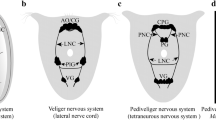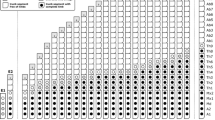Summary
In larvae of Diplosoma macdonaldi one sensory nerve extends along the dorsal midline of the tail and another extends along the ventral midline. Each nerve is composed of 50–70 naked axons lying in a groove in the base of the epidermis, and each projects to the visceral ganglion. The cell bodies of the caudal sensory neurons occur in pairs within the epidermis, and are situated along the courses of the nerves. A single cilium arises from an invagination in the soma of each neuron, passes through the inner cuticular layer of the tunic and enters a tail fin formed by the outer cuticular layer. We propose that these cells are mechanoreceptors. The caudal sensory system is similar in representative species of ten families of ascidians.
Similar content being viewed by others
Abbreviations
- a :
-
axial complex of the tail
- ac :
-
accessory centriole
- ax :
-
axon
- bb :
-
basal body
- bl :
-
basal lamina
- c :
-
cilium
- cep :
-
common epidermal cells
- cs :
-
ciliary sheath
- dcv :
-
dense-cored vesicles
- dsn :
-
dorsal sensory nerve
- ec :
-
ependymal cells
- ep :
-
epidermis
- gj :
-
gap junction
- h :
-
hemocoel
- hc :
-
hemocoelic chamber
- icl :
-
inner cuticular layer of the tunic
- m :
-
caudal muscle
- nc :
-
dorsal nerve cord
- ncl :
-
neurocoel
- no :
-
notochord
- ocl :
-
outer cuticular layer of the tunic
- sc :
-
sensory cell
- sn :
-
sensory nerve
- sv :
-
sensory vesicle
- vg :
-
visceral ganglion
- vsn :
-
ventral sensory nerve
References
Altner H, Prillinger L (1980) Ultrastructure of invertebrate chemo-, thermo- and hygroreceptors and its functional significance. Intern Rev Cytol 67:69–139
Anderson H, Edwards JS, Palka J (1980) Developmental neurobiology of invertebrates. Ann Rev Neurosci 3:97–137
Barnes SN (1971) Fine structure of the photoreceptor and cerebral ganglion of the tadpole larva of Amaroucium constellatum (Verrill) (Urochordata, Ascidiacea). Z Zellforsch Mikrosk Anat 117:1–16
Barnes SN (1974) Fine structure of the photoreceptor of the ascidian tadpole during development. Cell Tissue Res 155:27–45
Bone Q, Ryan KP (1978) Cupular sense organs in Ciona (Tunicata:Ascidiacea). J Zool London 186:417–429
Bullock TH, Horridge GA (1965) Structure and function in the nervous systems of invertebrates, vol. 2. WH Freeman, San Francisco
Cavey MJ, Cloney RA (1972) Fine structure and differentiation of ascidian muscle I. Differentiated caudal musculature of Distaplia occidentalis tadpoles. J Morphol 138:349–374
Cavey MJ, Cloney RA (1976) Ultrastructure and differentiation of ascidian muscle I. Caudal musculature of the larva of Diplosoma macdonaldi. Cell Tissue Res 174:289–313
Cloney RA (1961) Observations on the mechanism of tail resorption in ascidians. Am Zool 1:67–87
Cloney RA (1969) Cytoplasmic filaments and morphogenesis: The role of the notochord in ascidian metamorphosis. Z Zellforsch Mikrosk Anat 100:31–53
Cloney RA (1978) Ascidian metamorphosis: Review and analysis. In: Chia F-S, Rice M (eds) Settlement and metamorphosis of marine invertebrate larvae. Elsevier, New York Oxford, pp 255–282
Cloney RA, Florey E (1968) Ultrastructure of cephalopod chromatophore organs. Z Zellforsch Mikrosk Anat 89:250–280
Cloney RA, Torrence SA (1982) Ascidian larvae: structure and settlement. In: Costow JD (ed) Biodeterioration. US Naval Inst, Annapolis
Eakin RM, Kuda A (1971) Ultrastructure of sensory receptors in ascidian tadpoles. Z Zellforsch Mikrosk Anat 112:287–312
Elwyn A (1937) Some stages in the development of the neural complex in Ecteinascidia turbinata. Bull Neur Inst NY 6:163–177
Grave C (1934) The Botryllus type of ascidian larva. Carnegie Inst Wash Publ 435:143–156
Laverack MS (1968) On the receptors of marine invertebrates. Oceanogr Mar Biol Ann Rev 6:249–324
Laverack MS (1974) The structure and function of chemoreceptor cells. In: Grant PT, Mackie AM (eds) Chemoreception in marine organisms. Academic Press, New York pp 177–265
Mackie GO, Bone Q (1976) Skin impulses and locomotion in an ascidian tadpole. J Mar Biol Ass UK 56:751–768
Tannenbaum AD, Rosenbluth J (1972) Myoneural junctions in larval ascidian tail. Experientia 28:1210–1212
Torrence SA (1980) The styelid photolith: A compound sense organ in ascidians. Am Zool 20:A890
Author information
Authors and Affiliations
Rights and permissions
About this article
Cite this article
Torrence, S.A., Cloney, R.A. Nervous system of ascidian larvae: Caudal primary sensory neurons. Zoomorphology 99, 103–115 (1982). https://doi.org/10.1007/BF00310303
Received:
Issue Date:
DOI: https://doi.org/10.1007/BF00310303




